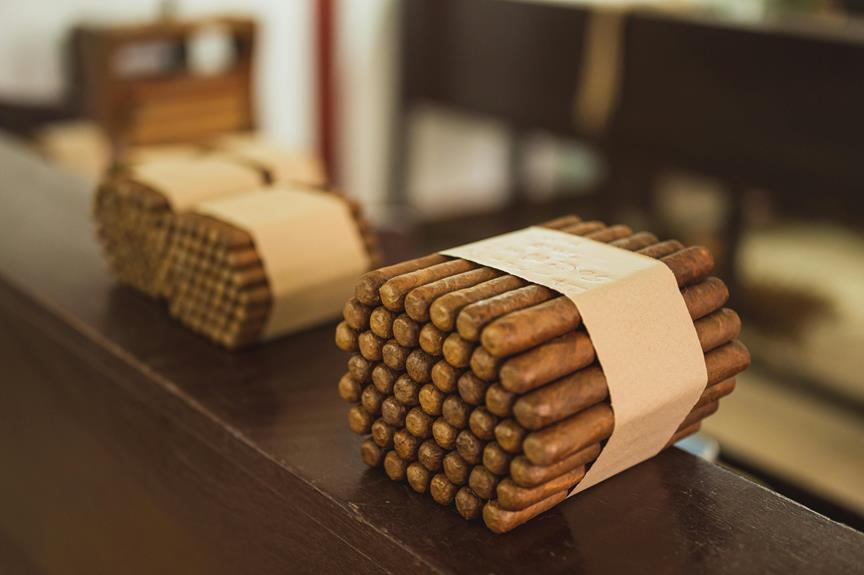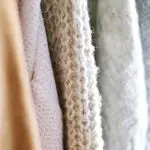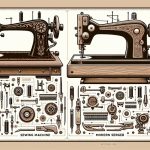When you consider the way overlocking fabric edges can transform your sewing projects, it's clear there's more to it than just a neat finish. This technique not only prevents fraying but also enhances the durability of your garments, ensuring they last longer than conventional methods. You'll find that it improves stitch quality and saves you both time and effort. Plus, its versatility across different fabric types makes it a worthwhile skill to master. But what really sets overlocking apart might surprise you, and it could change how you approach your next project.
Table of Contents
Key Takeaways
- Overlocking prevents fabric fraying, creating neat edges that enhance the aesthetic of sewing projects and save time during finishing.
- It improves durability by strengthening seams, extending the lifespan of garments and resisting wear from frequent use.
- Overlocked edges provide a polished appearance with consistent stitch quality, minimizing loose threads and ensuring a professional finish.
- The process saves time and effort, streamlining sewing tasks and allowing for greater focus on creativity and design.
Prevents Fabric Fraying
Overlocking fabric edges effectively prevents fraying, ensuring your projects maintain a clean and polished look. When you cut fabric, the threads can easily unravel, leading to a messy, unprofessional finish. By using an overlocker, you're able to create a secure stitch that wraps around the fabric edges, locking the threads in place.
This technique is especially crucial for fabrics that are prone to fraying, such as knits or loosely woven textiles. If you don't overlock these edges, you'll likely end up with unsightly threads that can ruin your hard work. Plus, overlocking provides a neat edge that can enhance the overall aesthetic of your project.
You'll also find that overlocking is a quick and efficient method. Instead of spending time folding and pinning hems or using zigzag stitches, you can simply run your fabric through the overlocker. It saves you time, allowing you to focus on other aspects of your sewing project.
Ultimately, preventing fraying through overlocking means your creations will look professional and stand the test of time, making it a valuable technique to master in your sewing journey.
Enhances Durability
When you overlock fabric edges, you're not just preventing fraying; you're also strengthening the overall structure of the fabric.
This extra layer of protection can significantly extend the lifespan of your garments.
Prevents Fraying Edges
Fraying edges can ruin the look and integrity of your fabric, but using an overlocker effectively prevents this issue, enhancing the overall durability of your project. When you overlock the edges, you're creating a secure finish that stops threads from unraveling. This is especially important for fabrics like knits or delicate materials, which tend to fray more easily.
By preventing fraying, you not only maintain a neat appearance but also extend the life of your fabric. Imagine putting in all that effort into a sewing project only to see it fall apart due to frayed edges. That's where the overlocker shines. It locks those threads in place, giving you confidence in your work.
Additionally, overlocking saves you time and effort in the long run. Rather than constantly having to trim or repair frayed edges, you can focus on creating your next masterpiece. It's a simple yet effective way to ensure your finished projects look polished and professional.
Strengthens Fabric Structure
Using an overlocker significantly strengthens the structure of your fabric, enhancing its overall durability for long-lasting projects. When you overlock the edges, you create a tightly woven seam that withstands stress better than traditional methods. This added support is especially beneficial for items that experience frequent movement or tension, like clothing, bags, or home textiles.
The overlocking process employs multiple threads that wrap around the fabric edges, providing a secure hold that prevents stretching or distortion. This means that your projects can endure regular wear and tear without compromising their integrity. Additionally, overlocked seams can handle the rigors of washing and drying, ensuring that your fabric maintains its shape and quality over time.
You'll also find that overlocking helps distribute the fabric's weight evenly, reducing the likelihood of tearing or fraying. This is crucial for heavier fabrics, where seams can become weak points.
Extends Garment Lifespan
Overlocking not only strengthens the fabric structure but also significantly extends the lifespan of garments by enhancing their overall durability. When you overlock fabric edges, you're creating a protective barrier that helps prevent fraying, unraveling, and wear and tear. This means your clothes can withstand daily use, keeping them looking new for longer.
Here's a quick comparison of overlocked versus non-overlocked seams:
| Feature | Overlocked Seams | Non-Overlocked Seams |
|---|---|---|
| Fraying Resistance | High | Low |
| Lifespan Extension | Significant | Minimal |
| Maintenance Frequency | Less Frequent | More Frequent |
Investing in overlocking is a smart choice for anyone looking to maintain the quality and longevity of their wardrobe. By choosing this technique, you're not just sewing; you're ensuring that your garments can handle the test of time and daily wear. So, next time you sew, consider overlocking those edges. You'll appreciate the difference in durability, and your clothes will thank you for it!
Improves Stitch Quality
Enhancing stitch quality, overlocking creates a secure finish that prevents loose threads and ensures durability in your fabric projects. When you overlock, you're effectively encasing the raw edges, which not only strengthens the seams but also minimizes the chances of fraying. This means your garments and other fabric items will look neater and more professional.
You'll notice that overlocked edges lie flatter and more evenly, which is crucial for achieving a polished appearance. The technique allows for a stretchable seam, accommodating fabric movement without compromising the integrity of the stitches. This is especially important for knit fabrics, where traditional sewing methods might lead to puckering or distortion.
Additionally, overlocking offers a variety of stitch options, giving you the flexibility to choose the best one for your specific fabric type. Whether you're working with lightweight silks or heavy denim, an overlock machine can adapt to your needs, ensuring a consistent stitch quality across different materials.
Saves Time and Effort
By streamlining the finishing process, overlocking not only enhances stitch quality but also saves you significant time and effort in your sewing projects. When you're working on multiple seams, the overlocker allows you to finish edges quickly without compromising on quality. You won't have to spend extra time switching between different machines, which means you can focus on creating instead of fussing with tools.
Here's a quick comparison of the time-saving benefits:
| Task | Traditional Method | Overlocking Method |
|---|---|---|
| Preparing seams | 15 minutes | 5 minutes |
| Finishing edges | 20 minutes | 10 minutes |
| Total time for 5 pieces | 175 minutes | 75 minutes |
With overlocking, you get to skip tedious steps like zigzagging edges or folding them over. Instead, you can set up your machine and let it do the work efficiently. This means more time for creativity and less time on repetitive tasks. So, if you want to maximize your productivity, investing in an overlocker is a smart choice!
Professional Appearance
A professional appearance in your sewing projects is easily achievable with the clean and polished edges that overlocking provides. When you overlock your fabric edges, you not only enhance the overall look of your project but also ensure durability and longevity. The seamless finish gives your work that tailored touch, making it stand out whether you're crafting garments or home décor.
Here are some benefits of achieving a professional appearance through overlocking:
- Enhanced Durability: Overlocked edges resist fraying, ensuring your projects withstand wear and tear.
- Consistent Stitching: The overlocker creates uniform stitches, giving your work a well-finished look.
In a world where presentation matters, overlocking elevates your sewing to a professional standard. You'll find that your finished products not only look great but also reflect your commitment to quality craftsmanship.
Versatile for Various Fabrics
Overlocking is incredibly versatile, allowing you to work with a wide range of fabrics from delicate silks to sturdy denim. When you decide to tackle various projects, this adaptability opens up endless possibilities. You can easily switch between lighter materials, like chiffon or lace, and heavier options, such as canvas or upholstery fabric.
Using an overlocker, you can achieve a clean finish on any fabric type, preventing fraying and enhancing durability. This means you don't have to limit your creativity based on fabric choice. Whether you're making a flowy dress, a structured jacket, or even home décor items, an overlocker handles it all with ease.
Moreover, overlocking isn't just about the fabric's weight; it also accommodates different textures. You'll find that it works well with knits, allowing for stretch without losing the integrity of the fabric. This flexibility is key when you're experimenting with various designs and styles.
Ultimately, having the ability to overlock different fabrics not only simplifies your sewing process but also elevates your finished projects, making them look polished and professional. So, embrace the versatility and let your imagination run wild!
Easy to Learn and Use
Learning to use an overlocker is straightforward, making it accessible even for beginners. You don't need to be a sewing expert to get started. With just a bit of practice, you can master the basics and enjoy the benefits of overlocking your fabric edges.
Here are a few reasons why overlockers are easy to learn:
- User-friendly Design: Most overlockers come with clear instructions and intuitive controls, so you can quickly understand how to operate them.
- Quick Setup: Changing threads and adjusting settings takes minimal time, allowing you to dive into your projects without frustration.
As you become more familiar with your overlocker, you'll find yourself experimenting with different techniques and styles. The learning curve is gentle, and you'll gain confidence with each project.
Soon, you'll wonder how you ever managed without it. Embrace the ease of overlocking and elevate your sewing game!
Frequently Asked Questions
Can Overlocking Be Used on Knitted Fabrics?
Yes, you can definitely use overlocking on knitted fabrics. It creates a clean finish while preventing fraying, and it helps maintain the stretchiness of the knit, ensuring your projects look great and last longer.
What Types of Machines Are Needed for Overlocking?
To overlock effectively, you'll need an overlock machine, often called a serger. These machines trim and stitch fabric edges simultaneously, creating a clean finish. A coverstitch machine can also be useful for hemming.
How Do I Maintain My Overlocker?
To maintain your overlocker, regularly clean the machine, oil moving parts, and replace needles when they're dull. Check tension settings often and refer to the manual for troubleshooting tips to ensure smooth operation.
Is Overlocking Suitable for All Fabric Types?
Overlocking's great for many fabric types, but it's not always suitable for delicate materials like silk or lace. You should test your fabric first to ensure it handles the overlocking process without damage.
Can Beginners Learn Overlocking Easily?
Absolutely, you can learn overlocking easily as a beginner! With some practice, you'll grasp the basics quickly. Tutorials and hands-on experience will boost your confidence, making it fun and rewarding to create beautiful fabric edges.
- How Does Ring Spun Cotton Affect Garment Fit and Shape Retention? - August 13, 2024
- What Are the Challenges in Producing Ring Spun Cotton? - August 13, 2024
- Is Ring Spun Cotton Suitable for Plus-Size Clothing? - August 13, 2024






